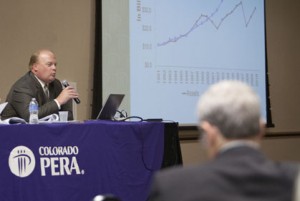UPDATE: Rachel Barkley, municipal credit analyst at Morningstar, responded to our inquiry. Here is what she had to say about PERA and DPS pension funding:
“…PERA has five plans, each with its own trust fund. Different levels of government contribute to each plan. The purpose of our report was to look at state plans, so the 57.7% referenced in the report is for the state division trust fund. It has the lowest funded level among the five funds and accounts for roughly 1/3 of PERA’s total liabilities. Denver Public Schools, which just merged with the system in 2010, has the highest funded level amongst the plans at 81.5% but accounts for a low 6% of total PERA liabilities. In aggregate, PERA is 61.2% funded, which is considered to be poor.”
 Filed under “we told you so”, a new report from Morningstar has found that Colorado’s public employee retirement plan (aka PERA) is one of 21 states’ retirement plans that is not fiscally sound. Morningstar came to this conclusion by examining the states’ aggregate ratios, or the pension plan’s assets divided by its liabilities. Those states, like Colorado, with aggregate ratios under 70 percent were deemed in danger. Colorado’s aggregate ratio is just 57.7%.
Filed under “we told you so”, a new report from Morningstar has found that Colorado’s public employee retirement plan (aka PERA) is one of 21 states’ retirement plans that is not fiscally sound. Morningstar came to this conclusion by examining the states’ aggregate ratios, or the pension plan’s assets divided by its liabilities. Those states, like Colorado, with aggregate ratios under 70 percent were deemed in danger. Colorado’s aggregate ratio is just 57.7%.
Here’s the catch – if PERA was to lower its expected return on planned assets, PERA’s liability (and thus the denominator in the equation) would grow tremendously causing the aggregate ratio to plummet further. Is this why the PERA board (exclusive of State Treasurer Walker Stapleton) is stubbornly clinging to the expected rate of return?
Stapleton has been a lone voice speaking out against the current expected rate of return. Approximately one month ago, we reported that PERA’s board ignored the advice of its financial adviser, who recommended that board lower the expected rate of return from 8% to 7.6% to reflect current market conditions.
At the time Stapleton said, “Now is the time to lower the rate of return, look at the real unfunded liability we are facing and figure out a solution to save the retirements of nearly 300,000 current and future retirees.”
Following Morningstar’s report, Democratic Speaker of the House Mark Ferrandino irrationally told the Denver Post, “There are some who would like to use the economic downturn to take away people’s pensions.”
Truthfully, the greatest threat to public employees’ retirements are those who refuse to face the reality of the situation (ahem, we’re talking to you, Democrats). Stapleton’s actions – and those on the PERA board who voted to lower the expected rate of return – are acting in the best interest of public employees in their attempts to shore up the underfunded plans.
Also of note, while Colorado’s aggregate ratio was found to be 57.7% overall, some of the pension’s departments were better off. The Denver Public School system (you know, the one that barely graduates 50% of its students?) is very well funded at 81.5%. If the DPS is funded at 81.5% and the average is 57.7%, what is the lowest rated department in PERA’s portfolio? We asked Morningstar, but have yet to receive a response.

"Approximately one month ago, we reported that PERA’s board ignored the advice of its financial adviser, who recommended that board lower the expected rate of return from 8% to 7.6% to reflect current market conditions.
CORRECTION – PERA ASKED FOR MORE THAN ONE OPINION, AS A RESPONSIBLE ORGANIZATION WOULD DO. THEY OPTED TO GO WITH THE RECOMMENDATION OF THEIR OTHER ADVISOR.
Following Morningstar’s report, Democratic Speaker of the House Mark Ferrandino irrationally told the Denver Post, “There are some who would like to use the economic downturn to take away people’s pensions.” This is a fact, and one that Walker Stapleton sees as HIS Initiative!
In the universe where water runs uphill, checks never bounce, and "government is only there to help you".
"PERA is 61.2% funded, which is considered to be poor.”.
Heavens! Next they'll be telling us that there is no Santa Claus!
Did they calculate how high they'd have to hike our taxes?
And the plan is for DPS to bring down its level of funding to be in line with the rest of the plan – In what universe is this good for employees?